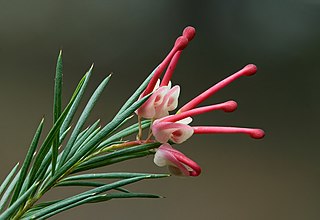
Grevillea rosmarinifolia, the rosemary grevillea, is a plant of the family Proteaceae.

Cryosophila williamsii, also known as Lago Yojoa palm or root-spine palm is a species of flowering plant in the family Arecaceae. It is found only in Honduras. It is threatened by habitat loss. Cryosophila williamsii is named in honor of prominent botanist Louis Otho Williams.
Guatteria anomala is a species of plant in the Annonaceae family. It is found in El Salvador, Guatemala, and Mexico. It is threatened by habitat loss.

Guatteria is a genus of flowering plants in the family Annonaceae. It is the largest genus in the family in South America, and the dominant genus in mature forest. The fruits are berries, borne in clusters on short stalks.
Guatteria atabapensis is a species of plant in the Annonaceae family. It is endemic to Venezuela.
Guatteria augusti is a species of plant in the Annonaceae family. It is endemic to Peru.
Guatteria calliantha is a species of plant in the Annonaceae family. It is endemic to Peru.
Guatteria excelsa is a species of plant in the Annonaceae family. It is endemic to Peru.
Guatteria ferruginea is a species of plant in the Annonaceae family. It is endemic to Suriname.
Guatteria geminiflora is a species of plant in the Annonaceae family. It is endemic to Peru.
Guatteria guentheri is a species of plant in the Annonaceae family. It is endemic to Peru.
Guatteria insignis is a species of plant in the Annonaceae family. It is endemic to Suriname.
Guatteria jefensis is a species of plant in the Annonaceae family. It is endemic to Panama. It is threatened by habitat loss.
Guatteria liesneri is a species of plant in the Annonaceae family. It is endemic to Venezuela.
Guatteria stenopetala is a species of plant in the Annonaceae family. It is endemic to Venezuela.
Guatteria tonduzii is a species of plant in the Annonaceae family. It is found in Colombia, Costa Rica, and Panama. It is threatened by habitat loss.
Guatteria ramiflora is a species of plant in the Annonaceae family. It is endemic to Peru.

The peyote, scientific name Lophophora williamsii, is a small, spineless cactus with psychoactive alkaloids, particularly mescaline. Peyote is a Spanish word derived from the Nahuatl peyōtl[ˈpejoːt͡ɬ], meaning "caterpillar cocoon", from a root peyōni, "to glisten". Peyote is native to Mexico and southwestern Texas. It is found primarily in the Sierra Madre Occidental, the Chihuahuan Desert and in the states of Nayarit, Coahuila, Nuevo León, Tamaulipas, and San Luis Potosí among scrub. It flowers from March to May, and sometimes as late as September. The flowers are pink, with thigmotactic anthers.
Many cacti are known to be psychoactive, containing phenethylamine alkaloids such as mescaline. However, the two main ritualistic (folkloric) genera are Echinopsis, of which the most psychoactive species is the San Pedro cactus, and Lophophora, with peyote being the most psychoactive species. Several other species pertaining to other genera are also psychoactive, though not always used with a ritualistic intent.
Guatteria boliviana is a species of flowering plant from the genus Guatteria, family Annonaceae, described by Hubert J.P. Winkler.




